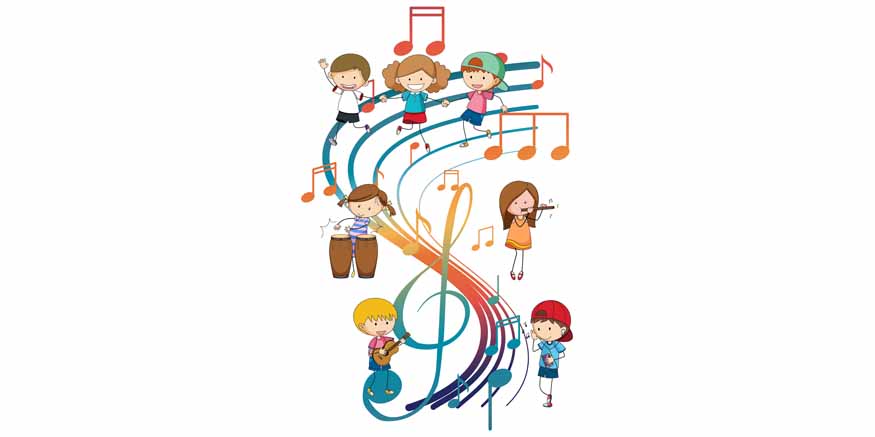Music and movement activities are an important part of the preschool stage. Activities like dancing, singing, and playing instruments help kids improve their motor skills, coordination, and sense of rhythm. They also boost analytical skills by enhancing memory, focus, and grip on language. Socially, these activities foster teamwork, emotional maturity, and communication skills. By including music and movement in everyday routines, teachers and parents can create an exciting environment that supports overall development.
Importance of music and movement in preschool
Music and movement help children grow physically, socially and emotionally. They enhance large muscle skills, coordination, and balance. Additionally, these activities let kids express their creativity and build self-confidence and self-esteem.

Music and movement also create opportunities for children to connect and socialise with others. They learn to share, cooperate, take turns, and work as a team. Engaging in music and movement can also boost children’s language and communication abilities by introducing them to new words and ideas through songs and actions. Here are some reasons why music and movement are important for child development:
- Promotes physical and motor skills growth
- Boosts language skills
- Strengthens social-emotional skills
- Boosts creativity
- Enhances thinking skills
- Promotes healthy habits
Music and movement activities help develop both large and small muscle groups. Activities like bouncing, clapping, stomping, dancing, and jumping encourage children to be active, supporting their physical growth. Playing instruments and engaging in finger-play songs also improve fine motor skills.
As children explore their movements, they learn how their bodies function and what they can do. This awareness can enhance their coordination and foster independence.
When children participate in activities like singing the alphabet song, clapping syllables, and playing instruments, they improve their phonological awareness, letter recognition, and other early literacy skills. Singing songs and reciting rhymes introduce new words and ideas, while also enhancing listening and comprehension abilities.
Singing and dancing together help children connect with others and feel a sense of belonging. These activities also teach social skills like taking turns, following rules, and sharing. The rhythm of music can calm and focus children, while physical movement helps release energy and tension, teaching them to manage their emotions.
Music and movement activities help kids be creative and use their imaginations. Children try out different sounds, rhythms, and movements to express themselves in unique ways while dancing or creating music with instruments.
Activities involving music and movement improve thinking skills like memory, categorisation, and problem-solving. For instance, songs that repeat and include counting can aid in memory and counting abilities. Kids can also learn to recognise patterns by noticing the beat, rhythm, and lyrics of a song, as well as sorting similar and different sounds and instruments.
Engaging in music and movement activities is a fun way for kids to stay active, which is important for their physical health. These activities also help children build healthy habits, like being active, that can last into their adult lives.
Music and movement activities for preschoolers

Adding music and movement to a preschool program is fun and helps kids grow. Here are some fun activities that can boost development and spark creativity.
- Singing and dancing
- Musical instrument exploration
- Freeze dance
- Musical chairs
- Animals in action
- Marching to the beat
It is fun to include simple songs with movements like clapping, stomping, or jumping in circle time or during activity changes. These actions help kids improve their large muscle skills, listening, memory, and sense of rhythm.
Giving children a variety of safe musical instruments, like shakers, drums, xylophones, and handbells, encourages them to explore and be creative. It also helps them develop their small muscle skills.
In this game, kids dance to music that sometimes stops. When the music pauses, everyone must freeze until it starts again. This game helps improve listening, coordination, awareness of space, and control over impulses.
This is a fun game that kids of all ages enjoy. Players walk or dance around a circle of chairs while music plays. When the music stops, everyone must quickly sit down. The one left standing is out, and one chair is taken away each round until only one player remains. To make it friendly, you can keep enough chairs for everyone. This game helps kids develop their large motor skills, learn to take turns and interact with others.
This song invites kids to copy different animal movements, allowing them to explore how they move and learn about various animals.
Play a song and teach kids to march to the rhythm of the music, either in the classroom or outside.
Conclusion
Adding music and movement activities to preschool education is important for the overall growth of children. These activities improve skills like memory and language while also supporting social, emotional, and physical development. Through musical games and rhythmic activities, children can express themselves creatively and enhance their coordination and awareness of space.
At Mother’s Pet Kindergarten, we understand how music and movement greatly influence early development. Our program includes these activities to provide a balanced education that enjoyably supports children’s growth. By creating a lively environment for children to explore music and movement, we help build a strong foundation for their lifelong learning and development.













Recent Comments